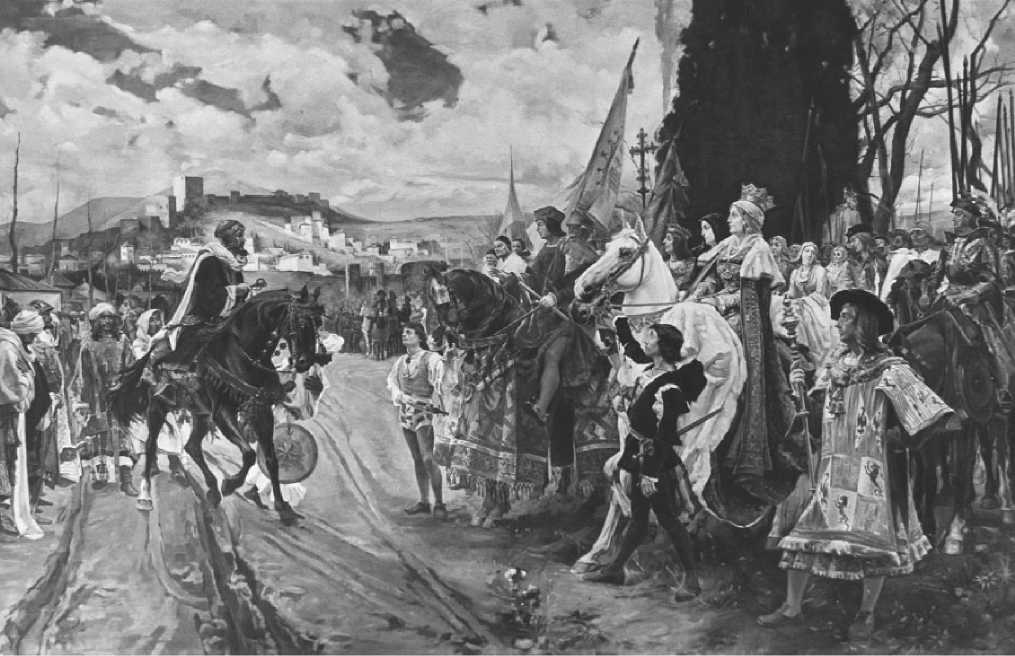The city of Granada was the capital of one of the most important of the Taifa kingdoms of eleventh-century Spain, and from around 1250 until 1492 it was the only surviving Muslim kingdom in the Iberian Peninsula.
The city became important for the first time under the Zirid dynasty and their Sanhaja Berber supporters when they established an independent kingdom there after the sack of Cordoba in 1013. Granada on its easily fortified hilltop site replaced Elvira, in the plains below, as the main local urban center. The Zirids built a citadel on what is now the Albaicin hill, and it rapidly became one of the most important cities in al-Andalus. During the course of the eleventh century, many of the smaller Taifa kingdoms were swallowed up by their larger neighbors and Granada was the only one of the Taifas of Andalusia strong enough to resist the expansion of Seville.
In 1056 the Zirids were able to take Malaga, which became a sort of second capital for the kingdom, entrusted to younger members of the ruling family. The kingdom was also noted for its influential Jewish community. Samuel ibn Naghrila was both the chief minister of the Zirid sovereigns

King Muhammad XII (Boabdil) hands over keys of the city to the Catholic monarchs, 1492. (Snark/Art Resource)
And an important Hebrew intellectual. In 1066 his son Joseph attempted a coup d’etat to put the ruler of Almeria, al-Mufitasim, on the throne. The attempt was thwarted by the Sanhaja Berbers, and the subsequent massacre greatly reduced the influence of the Jews. The Zirids maintained their independence until the last of them, ‘Abd Allah ibn Buluggin, author of the famous memoirs known as the Tibyan, was deposed by the Almoravids in 1090 and carried off into exile in Morocco.
Under Almoravid and Almohad rule (1091-1250), Granada remained an important provincial center, although Seville was the real capital. With the collapse of Almohad rule in the 1230s and 1240s, the position of the Muslims in al-Andalus became increasingly desperate. When Cordoba (1236) and Seville (1248) were taken by Ferdinand III, king of Castile, the rich and fertile lands of the Guadalquivir Valley were lost, and it must have seemed as if the days of Muslim political power were coming to an end.
Around 1246 Granada was seized by Muhammad ibn
Yusuf ibn Nasir, known as Ibn al-Ahmar. He came from a family of Arab origin long established in al-Andalus that does not seem to have played an important political role before. He realized that the only way to preserve his independence was by cooperation with the Castilians. He accepted Ferdinand III of Castile as his overlord and sent troops to help the Castilians in the final assault on Seville in 1248. He made no effort to help the insurgents in the great Muslim rebellion of 1264-1266 in Andalusia. As a reward, he was allowed to consolidate his power, and no effort was made to conquer his mountain kingdom. When he died in 1272, his power was inherited by his son, also named Muhammad (1272-1302), and the Nasrid dynasty was founded.
The fourteenth century was the golden age of the kingdom of Granada. It stretched along the south coast of Spain and into the mountains behind from beyond Almeria in the east to Algeciras in the west. The city of Granada itself expanded greatly. The Nasrids established themselves in the fortified palace since known as the Alhambra. Here, throughout the fourteenth century, they constructed the network of courts and palaces that have survived as the most perfect example of a medieval Muslim palace. The city below was developed as a commercial and silk-making center. There were important colonies of Genoese merchants in Granada itself, Malaga, and Almeria.
The frontiers with Castile remained more or less static throughout the fourteenth century and the early part of the fifteenth, apart from the definitive loss in 1344 of Algeciras, which was taken by King Alfonso IX, assisted by northern European crusaders, including Henry of Lancaster. The survival of the kingdom against the might of Castile can be attributed to a number of factors. The geography of the southern mountains meant that the kingdom was well protected by steep mountains and narrow passes. It was also fairly densely populated. Many Muslim refugees had come from the neighboring lands now under Christian rule, while much of Christian Andalusia was very sparsely inhabited; there was no demographic pressure on the kingdom.
In the early years the kingdom also gained some support from the Marinids, who had succeeded the Almohads in Morocco. The Nasrids were able to play off Marinids and Castilians and give themselves some diplomatic room for maneuver. After their defeat at the battle of the Rio Salado (1340), however, the Marinids were no longer a power in the Iberian Peninsula, and the Nasrids were left without allies. Marinid power in North Africa soon disintegrated. They were helped by internal political dissension in Castile, the ambitions of King Alfonso X to become Holy Roman Emperor, the upheavals of the Trastamara revolution in 1369, and the almost continuous strife between the Castilian Crown and nobles in the late fourteenth and fifteenth centuries. The kingdom of Granada paid valuable tribute to the kings of Castile, who were always short of money, and it was probably more valuable to them as a source of tribute than it would have been conquered and divided up among the nobility. The frontier with Granada became the scene of chivalric skirmishes and the setting for frontier ballads. But until the end of the fifteenth century and the reigns of the “Catholic Monarchs,” Ferdinand II of Aragon and Isabella I of Castile, there was little serious attempt at conquest.
In 1482 a Castilian force took the town of Alhama de Granada in the heart of the kingdom, and this marked the beginning of a new, aggressive policy, while Granada was weakened by continual internal feuds. The Christians were now using new and more effective artillery to reduce Muslim fortified towns, such as Ronda, which fell in 1486. In the same year the fall of Loja left the plain of Granada wide open to Christian attack. Throughout 1490 and 1491 the Christians closed in on Granada. On 25 November 1491 the surrender of the city was negotiated, and on 1 January 1492 the Christian forces entered the Alhambra itself.
The terms under which the city had surrendered allowed wide freedoms to the Muslim population, who were entitled to keep their property and practice their religion openly. For eight years the provisions were respected; Granada was essentially a Muslim city with a small Christian ruling elite. From 1500 things began to change. A revolt in the Alpujarra Mountains against the oppressive policies of Cardinal Cisneros gave the more militant Christians their excuse. Within a generation, the practice of Islam and Muslim customs had been effectively exterminated, and Granada became a truly Christian city.
-Hugh Kennedy
Bibliography
Arie, Rachel, L’Espagne musulmane au temps des Nasrides, 2d ed. (Paris: De Boccard, 1990).
Grabar, Oleg, The Alhambra (London: Lane, 1978).
Harvey, Leonard P., Islamic Spain, 1250 to 1500 (Chicago: University of Chicago Press, 1990).
Kennedy, Hugh, Muslim Spain and Portugal (London: Longman, 1996).
The Tibyan: Memoirs of‘Abd ‘Allah b. Buluggin, Last Zirid Amir of Granada, trans. Amin Tibi (Leiden: Brill, 1986).




 World History
World History









